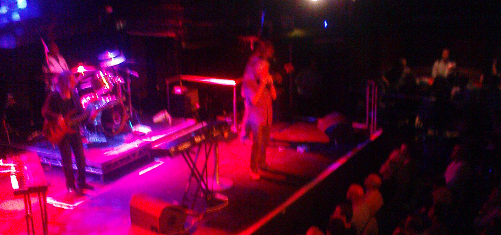
My one presiding memory of visiting my granddad when I was knee high to a shepherd’s pie is, of all things, screwing around with the old man’s stair lift. Utterly lost on me and my brother was the importance of the machine for allowing my granddad easy ascent – all we saw was a hilarious toy that distracted us from the boring grown-up talk that was going on around us. I’m fairly certain we broke it at least twice, but hey, boys will be boys. Or, in this case, boys will be annoying little brats.
I’d like to think that, years from now, as I progress into bitterly cynical old age, beset by rare liver diseases and with limited vision out of my one remaining good eye, as long as I have a stair lift, I’ll still have the capacity to feel like a demented four year old kid, taking innocent delight in the simple act of gliding up and down a banister. Hell, maybe it’ll be even easier, thanks to the senility and all.
It’s doubtful that 75-year-old John Mayall requires a stair lift – not even for simple-minded giddy thrills. In fact, judging from his very infectious, copious energy as he commanded the stage at the Academy on Tuesday, it’s music that’s keeping the man young, and it seemed to rejuvenate the crowd as much as it did Mayall himself. It was immediately obvious that a large portion of the crowd had grown old along with Mayall, and each pounded piano chord was a glorious sonic bridge back into their collective youths.
Not that the show was a mere nostalgia trip – rather, Mayall’s blues have remained vital and powerful, propelled by the drums of Jay Davenport, and given searing strength by the organist Tom Canning and guitarist Rocky Athas. And out in front, Mayall energetically switched between piano and harmonica: the memorable opening tune, a cover of Sonny Boy Williamson’s “Another Man Done Gone”, featured Mayall standing alone on the sparse stage, providing his weathered voice with lonely accompaniment on his blues harp.
At times it was hard to tell how exactly Mayall remained standing for the entire gig. As the band blazed through songs like “Chicago Line” and “Room To Move”, he threw in breakneck harmonica licks between lines, seemingly never pausing for breath. It was a virtuoso performance, ably matched by his cohorts; the work of a man whose devotion to the blues is as inspiring as it is tireless.
The moments when they switched things up slightly were wondrous: a rolling New Orleans shuffle gave “Congo Square” a soulful backbone; the phased guitar attack of “Dream About The Blues” gave the paean to the Delta Blues a dark edge.
Of course, all that said, if lengthy blues jams aren’t your thing, seeing this show would have been like an emetophobe attending a Bulimics Anonymous meeting – wearying and a little masochistic. Mayall’s democratic leadership and fierce love for the music meant that every song had an extended solo section, giving each band-member numerous chances to show their skills. It did, however, give rise to the wonderful phenomenon of particularly splendid solos getting their own round of applause from the enraptured crowd, so that was nice.
But beyond the sterling musicianship, and Mayall’s Rolf Harris-esque appearance, was a meaningful legacy: for a man whose own legend is often overshadowed by the legends he helped create (Mayall’s Bluesbreakers gave Eric Clapton, Mick Taylor, Jack Bruce, Peter Green, Mick Fleetwood and John McVie a leg-up on the British club scene, amongst others – it’s an astonishing list), Mayall has earned the respect and admiration of countless music-lovers, and they came out in force for this show. As they stormed the front of the stage at the end of the gig, clutching classic vinyls for Mayall to sign, it wasn’t hard to envision the Academy as a 1960’s club, and all the adoring, getting-on-in-years fans as excited twenty-somethings seeing the pioneer of British blues in action for the first time. It would have been quite a powerful moment if I wasn’t such a cold, soulless hate-machine.
Admittedly, that’s quite a big “if”. Maybe I should invest in that stair lift.


